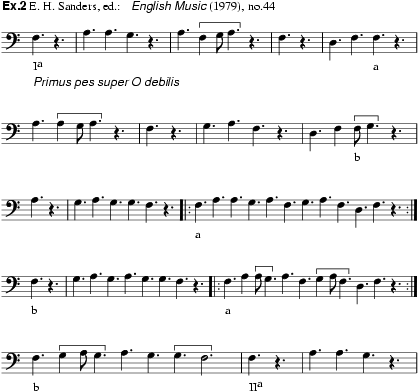
(Lat.: ‘foot’, ‘fundament’, ‘ground’).
In some English sources of polyphony dating from the second half of the 13th century (mostly the so-called Worcester Fragments, now in the Bodleian Library and Worcester Cathedral: see Worcester polyphony) pes is the usual designation for the untexted non-Gregorian tenor of certain motets; it was freely invented or, more rarely, borrowed from a song or a dance-tune. The term generally denotes a strict or varied melodic ostinato, in contrast to the purely rhythmic ostinatos into which continental motet composers fashioned their cantus firmi. While the cantus firmus motets written in England follow continental precepts, the pes motets are an English speciality.
At first pes seems to have designated the supporting voice of motets whose upper two voices engage in voice-exchange (the commonly accepted term for a 13th-century technique that more precisely would be called phrase-exchange). In such motets the phrase elements of the pes are fairly short (ex.1), typically producing the polyphonic design:
CBED
BCDE
AAA'A'
(The same compositional procedure, but without the designation of the tenor as pes, occurs in some passages of English Conductus, both cum littera and sine littera.) Sumer is icumen in (see also for facsimile) can appropriately be included in this group of compositions, especially in view of its alternative Latin text. Some of the motets without voice-exchange have pedes with rather long repeated elements, which are, however, generally subdivisible into variant segments (ex.2).

In addition to the Summer Canon, there are two cases in which the pes, not so designated in the manuscript, carries an ostinato text (English Music, no.45, and US-PRu Garrett 119, no.B1). A few compositions in which only one upper voice, supported by two pedes (e.g. primus pes and secundus pes), has text constitute a special kind of accompanied solo song. (A similar, though much later specimen – early 15th-century – of probable English origin is a Latin song, supported by a slow italianate tenor which is designated as a rondellus (I-TRmp 87, ff.252v–253); cf also Cornysh’s A robyn, gentyl robyn.) The term pes evidently became common enough in the ‘Worcester school’ to be applied to the lowest voice of three motets actually based on plainchant cantus firmi (English Music, nos.67, 73, 80). The following compositions have a bottom voice specifically and properly labelled pes: English Music, nos.47–51, 53–4; the Summer Canon; the Worcester Fragments, nos.7, 17, 30, 74, 75. No medieval writer on music reported the use or meaning of the term in the English polyphony of the time.

HarrisonMMB
K.J. Levy: ‘New Material on the Early Motet in England: a Report on the Princeton MS Garrett 119’, JAMS, iv (1951), 220–39
L.A. Dittmer: ‘Beiträge zum Studium der Worcester-Fragmente’, Mf, x (1957), 29–39
L.A. Dittmer: The Worcester Fragments: a Catalogue Raisonné and Transcription, MSD, ii (1957)
E. Apfel: Studien zur Satztechnik der mittelalterlichen englischen Musik (Heidelberg, 1959), chap.1
E.H. Sanders: ‘Tonal Aspects of 13th-Century English Polyphony’, AcM, xxxvii (1965), 19–34
H. Tischler: ‘A Three-Part Rondellus in Trent MS 87’, JAMS, xxiv (1971), 449–57
E.H. Sanders, ed.: English Music of the Thirteenth and Early Fourteenth Centuries, PMFC, xiv (1979)
P.M. Lefferts: The Motet in England in the Fourteenth Century (Ann Arbor, 1986)
ERNEST H. SANDERS